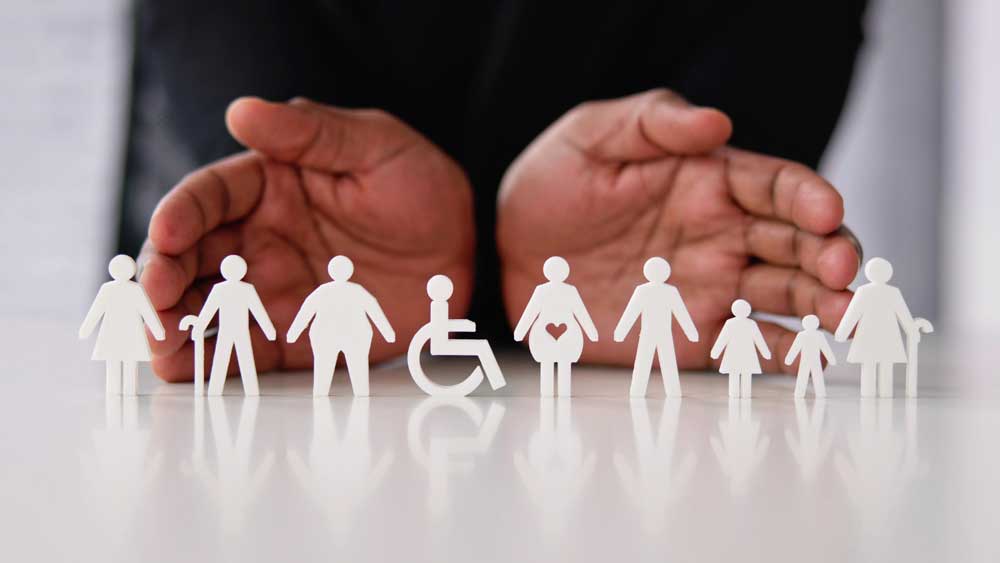
Building Resilience through Universal Social Protection

As the world continues to face the devastating effects of climate change, it is becoming increasingly clear that social protection systems, whether in cash or in-kind benefits, contributory or non-contributory schemes, can play a critical role in building resilience and helping communities adapt. At the country level, universal social protection can serve as an entry point for climate change adaptation, helping vulnerable populations to weather the impacts of extreme climate events, loss of livelihoods, and other disruptions.
Universal Social Protection and its Role in Climate Change Adaptation
The World Bank and ILO define Universal Social Protection (USP) as a nationally defined system of policies and programmes that provide equitable access to all people and protect them throughout their lives against poverty and risks to their livelihoods and well-being. This can include everything from cash transfers to health care services to employment programmes, all of which can help families cope with life cycle risks, climate risks, and other crises.
For example, in Pakistan, the National Rural Support Programme’s (NRSP) Waseela-e-Taleem (WeT) Programme provides cash assistance to poor families with school-aged children. This conditional cash transfer has helped increase school enrollment and attendance in 10 districts.
At the heart of Universal Social Protection is the idea that everyone, regardless of their income or status, should have access to basic support when they need it. This can be especially important in the context of climate change, where extreme weather events and other cascading climate impacts can have a disproportionate effect on the most vulnerable members of society.
Social Protection as a Tool for Climate Change Adaptation
In recent years, social protection as a key tool for climate change adaptation has gained traction as concepts such as adaptive social protection, climate responsive social protection, and shock-responsive social protection are used in practice. In Kenya, the Hunger Safety Net Programme provides cash transfers to extremely poor households in Northern Kenya and temporary emergency cash transfers to affected households when there are triggers of severe and extreme drought or floods.
By providing a safety net for those most at risk, social protection programmes can help to reduce the impact of climate change on financial standing, food security, health, as well as on other aspects of life. In addition, they can support the development of more resilient communities, helping people to recover from shocks and build a more sustainable future.
The Power of Social Protection in Climate Change Resilience
The power of social protection in the face of climate change can be seen in the R4 Rural Resilience Initiative implemented by the World Food Programme and OXFAM in over 10 countries in Africa, Asia, and Latin America and the Caribbean. This initiative combines climate risk insurance with social protection to cushion farmer households from different risks. It applies four risk management strategies: reducing climate-related risk through nature-based solutions and improved agricultural practices; risk transfer through private insurance; risk retention through promoting group saving integrated with social protection systems; promoting prudent-risk taking through a combination of capacity building in financing, livelihoods diversification, and easier access to credit. Insurance protects farmers against extreme climate events like droughts while activities under the cash-for-work programme help them build assets and invest in natural resources management.
Though approaches that link social protection with climate risk management face some limitations like weak integration with broader global/national agendas and strategies on climate change and sustainable development as pointed out by Aleksandrova and Costella; overall, universal social protection can serve as a critical entry point for climate change adaptation especially at the county level.
Conclusion
As we continue to grapple with the impacts of climate change, it is evident that social protection will be an essential tool in the fight to build a more just, resilient, and sustainable future.
SDGs, Targets, and Indicators
| SDGs | Targets | Indicators |
|---|---|---|
| SDG 1: No Poverty | Target 1.3: Implement nationally appropriate social protection systems and measures for all, including floors, and by 2030 achieve substantial coverage of the poor and the vulnerable | Indicator 1.3.1: Proportion of population covered by social protection floors/systems, by sex, distinguishing children, unemployed persons, older persons, persons with disabilities, pregnant women, newborns, work-injury victims, and the poor and the vulnerable |
| SDG 2: Zero Hunger | Target 2.1: By 2030, end hunger and ensure access by all people, in particular the poor and people in vulnerable situations, including infants, to safe, nutritious and sufficient food all year round | Indicator 2.1.2: Prevalence of moderate or severe food insecurity in the population, based on the Food Insecurity Experience Scale (FIES) |
| SDG 3: Good Health and Well-being | Target 3.8: Achieve universal health coverage, including financial risk protection, access to quality essential health-care services and access to safe, effective, quality and affordable essential medicines and vaccines for all | Indicator 3.8.1: Coverage of essential health services (defined as the average coverage of essential services based on tracer interventions that include reproductive, maternal, newborn and child health, infectious diseases, non-communicable diseases and service capacity and access) |
| SDG 13: Climate Action | Target 13.1: Strengthen resilience and adaptive capacity to climate-related hazards and natural disasters in all countries | Indicator 13.1.1: Number of deaths, missing persons and directly affected persons attributed to disasters per 100,000 population |
| SDG 17: Partnerships for the Goals | Target 17.14: Enhance policy coherence for sustainable development | Indicator 17.14.1: Number of countries with mechanisms in place to enhance policy coherence of sustainable development |
1. Which SDGs are addressed or connected to the issues highlighted in the article?
SDG 1: No Poverty
The article discusses how social protection systems can help vulnerable populations weather the impacts of extreme climate events and loss of livelihoods, contributing to poverty reduction.
SDG 2: Zero Hunger
The article mentions how social protection programs can support food security by providing a safety net for those most at risk, reducing the impact of climate change on food security.
SDG 3: Good Health and Well-being
The article highlights the role of social protection in protecting health and well-being, especially in the context of climate change and its impacts on health.
SDG 13: Climate Action
The article emphasizes the importance of social protection systems in building resilience and adapting to climate change, reducing the impact of climate-related hazards and natural disasters.
SDG 17: Partnerships for the Goals
The article mentions the need for policy coherence in integrating social protection with climate risk management and broader global/national agendas on climate change and sustainable development.
2. What specific targets under those SDGs can be identified based on the article’s content?
– Target 1.3: Implement nationally appropriate social protection systems and measures for all, including floors, and by 2030 achieve substantial coverage of the poor and the vulnerable.
– Target 2.1: By 2030, end hunger and ensure access by all people, in particular the poor and people in vulnerable situations, including infants, to safe, nutritious and sufficient food all year round.
– Target 3.8: Achieve universal health coverage, including financial risk protection, access to quality essential health-care services and access to safe, effective, quality and affordable essential medicines and vaccines for all.
– Target 13.1: Strengthen resilience and adaptive capacity to climate-related hazards and natural disasters in all countries.
– Target 17.14: Enhance policy coherence for sustainable development.
3. Are there any indicators mentioned or implied in the article that can be used to measure progress towards the identified targets?
– Indicator 1.3.1: Proportion of population covered by social protection floors/systems, by sex, distinguishing children, unemployed persons, older persons, persons with disabilities, pregnant women, newborns, work-injury victims, and the poor and the vulnerable.
– Indicator 2.1.2: Prevalence of moderate or severe food insecurity in the population, based on the Food Insecurity Experience Scale (FIES).
– Indicator 3.8.1: Coverage of essential health services (defined as the average coverage of essential services based on tracer interventions that include reproductive, maternal, newborn and child health, infectious diseases, non-communicable diseases and service capacity and access).
– Indicator 13.1.1: Number of deaths, missing persons and directly affected persons attributed to disasters per 100,000 population.
– Indicator 17.14.1: Number of countries with mechanisms in place to enhance policy coherence of sustainable development.
4. SDGs, Targets, and Indicators
| SDGs | Targets | Indicators |
|---|---|---|
| SDG 1: No Poverty | Target 1.3: Implement nationally appropriate social protection systems and measures for all, including floors, and by 2030 achieve substantial coverage of the poor and the vulnerable | Indicator 1.3.1: Proportion of population covered by social protection floors/systems, by sex, distinguishing children, unemployed persons, older persons, persons with disabilities, pregnant women, newborns, work-injury victims, and the poor and the vulnerable |
| SDG 2: Zero Hunger | Target 2.1: By 2030, end hunger and ensure access by all people, in particular the poor and people in vulnerable situations, including infants, to safe, nutritious and sufficient food all year round | Indicator 2.1.2: Prevalence of moderate or severe food insecurity in the
Copyright: Dive into this article, curated with care by SDG Investors Inc. Our advanced AI technology searches through vast amounts of data to spotlight how we are all moving forward with the Sustainable Development Goals. While we own the rights to this content, we invite you to share it to help spread knowledge and spark action on the SDGs. Fuente: unssc.org
Join us, as fellow seekers of change, on a transformative journey at https://sdgtalks.ai/welcome, where you can become a member and actively contribute to shaping a brighter future.
|




